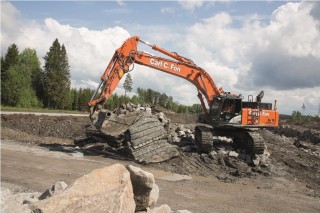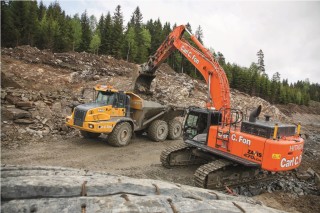The latest range of Hitachi Zaxis-5 excavators is being used to test the innovative fuel as an eco-friendly solution at the Hitachi factory in Amsterdam. This follows tests in Norway earlier in the year in sub-zero conditions.
Shell GTL fuel is produced from natural gas in a chemical transformation process. The basic technology behind GTL is known as the Fischer-Tropsch process, which was developed by German scientists in the 1920s and refined by Shell’s proprietary technology. Firstly (it says here) the natural gas is converted into CO and H2, which are then combined in the Fischer-Tropsch process to form paraffins. These are refined through hydrocracking into various synthetic products, including GTL fuel.
I am reliably informed that the resulting fuel is colourless, almost odourless, highly biodegradable and can help to reduce local emissions and engine noise (but only in certain types of engines and under certain driving conditions). It has a high cetane number (75/80 versus 48/56 for refined diesel), burns more cleanly, and produces fewer nitrogen oxides, sulphur oxides and particulate matter than regular diesel.
Shell opened its first GTL production plant in Bintulu, Malaysia, in 1993 and inaugurated the world-scale Pearl GTL plant in Ras Laffan, Qatar, in 2011. The plant has a capacity to produce around 140,000 barrels of GTL products per day.
“Shell GTL Fuel is compatible with existing diesel technology and supply infrastructure,” says Igor de Liefde, who is responsible for product regulations in HCME’s engineering department. “This means that we can use it in existing fleets – for both new and older heavy-duty diesel engines – without the need for any modifications, cleaning of fuel systems or additional investment. This makes it a cost-effective, easy-to-use and easy-to-implement solution, which importantly doesn’t add complexity to a customer’s business.”

HCME has been using a ZX210LC-5 medium excavator for a Shell GTL fuel storage stability test. The purpose was to run the engine for the minimum amount of time, so that the fuel was stored for as long as possible in the tank under the most demanding conditions.
HCME and Shell also sanctioned a cold operability test with two Stage IIIB-compliant ZX470LCH-5 machines in Norway earlier this year (pictured above and below). The Zaxis excavators are owned by one of the country’s largest Hitachi customers, Carl C Fon, which was working on a road construction project where temperatures were as low as -20°C.
“The fact that it needed to be tried out in severe winter conditions meant that Norway and this site in particular were ideal,” says owner Carl Christian Fon. “I have full confidence in Shell GTL Fuel. We had no running problems, the fuel consumption was similar to diesel and there were less local emissions. As it can be a cost-effective fuel option, we would have no hesitation in using it on a permanent basis.”
One of the ZX470LCH-5 operators, Petter Flåtten, who has 28 years’ experience in his profession, says, “I really couldn’t tell the difference in performance between Shell GTL Fuel and regular diesel. If I took a blindfold test with two identical machines using the different fuels, I would be able to identify Shell GTL Fuel, because: it doesn’t smell; there’s less engine noise; and it helps the machine to start easily in freezing conditions.”



